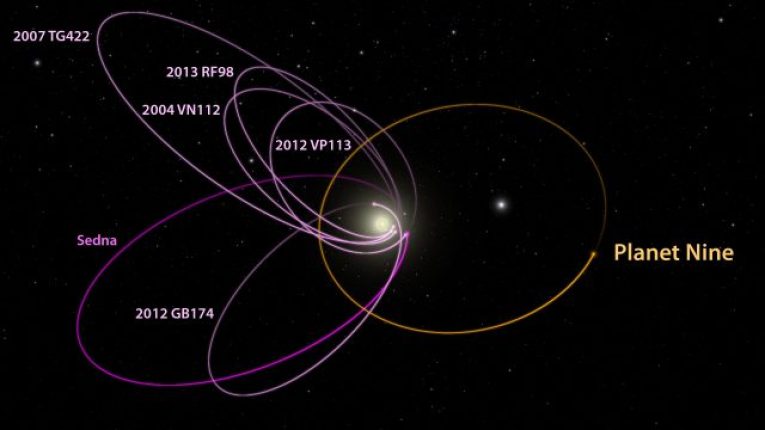Somewhere, lurking out in the inky blackness at the edge of our star system, may be an undiscovered planet. A new analysis supports the notion that there’s something else out there, big enough to be the 9th true planet, and narrows the region we need to search if we want to find the elusive Planet Nine.
Astronomers started talking seriously about a ninth planet in 2016 when Caltech’s Mike Brown and Konstantin Batygin published their study detailing the unusual orbital behavior of Kuiper Belt Objects (KBOs). These icy chunks of rock orbit the sun out beyond the orbit of Neptune.
Pluto was demoted from “planet” to “dwarf planet” in August of 2006, because it met every criterion for being a planet save one: it was discovered that it had not cleared the space around it of other objects. It was, however, the first Pluto might not be a planet anymore, but it was the first KBO ever discovered.
According to the original study, the uneven distribution of orbits among KBOs points to the presence of a massive object in the outer solar system that we haven’t found yet. We’ve been looking since the report was published, but so far our searches have all come up empty.

While some astronomers believe Planet Nine is a good explanation for KBO orbits, there has also been intense criticism of the study. Now, Brown and Batygin are back with a new analysis that tries to address some of those complaints. Chiefly, other scientists noted that it’s difficult to observe KBOs, so many searches focus on the more convenient regions of the sky – which means we could simply be looking in the wrong place because it’s convenient to do so.
Brown and Batygin kept kept some of the original KBOs in the new data set, but they added some new ones. They also discarded anything that looked like it might be influenced by the gravity of Neptune. After winnowing it down to 11 KBO’s, they’re all still showing unusual orbital distribution.
According to the study, there’s only a 0.4% chance that these orbits happened by accident. That means that there is a greater than 99% chance that there is a massive something out there making their orbits do this.
Based on the new simulations, Batygin has created a “treasure map” of sorts that points the way to Planet Nine’s most likely orbital arc. The map shows an area that crosses the Milky Way from our point of view, which might have helped hide Planet 9 from previous planet hunters. The expected orbit brings its orbital period to something in the neighborhood of 7,400 of our years (the original analysis had it at closer to 18,500 years).
The two astronomers believe that we are only a few years away from spotting Planet 9. The pair believe we are only a few years away from spotting Planet Nine, and it may be the upcoming Vera Rubin Observatory in Chile that does it. The new observatory has vastly greater field of view than other observatories, and Brown and Batygin feel that this may give the telescope the needed edge that will finally help locate the missing world.
-30-
![]()
SCIFI.radio is listener supported sci-fi geek culture radio, and operates almost exclusively via the generous contributions of our fans via our Patreon campaign. If you like, you can also use our tip jar and send us a little something to help support the many fine creatives that make this station possible.












